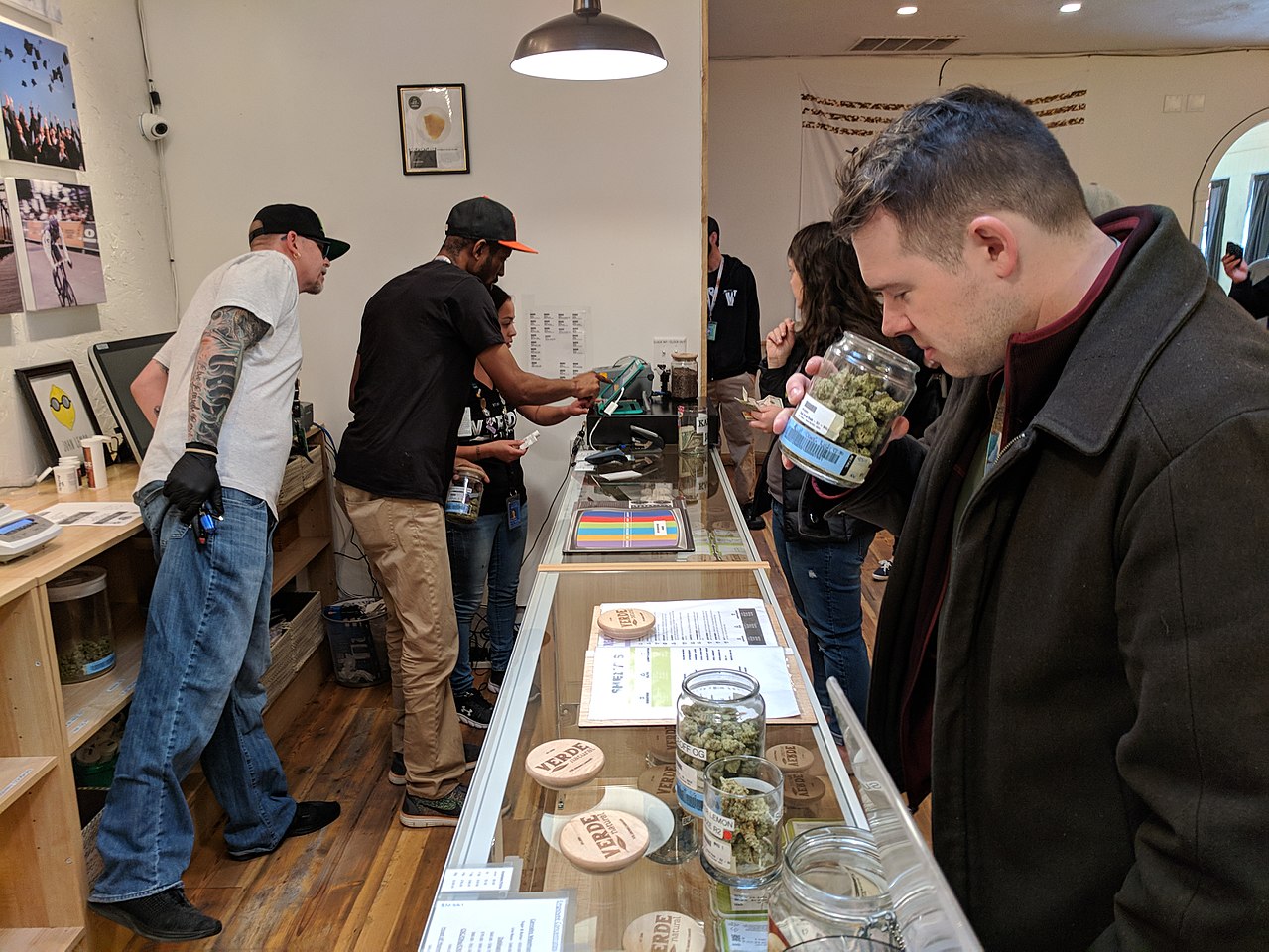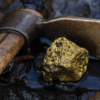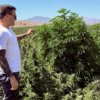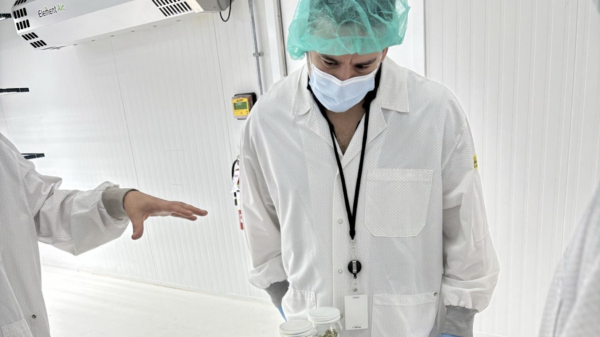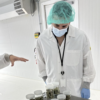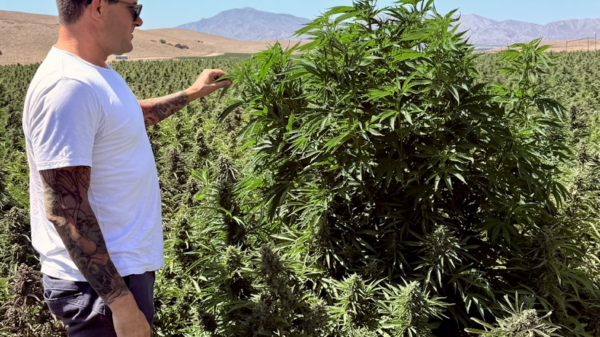When it comes to weed, you shop with your nose.
Or at least that’s the way things have been done traditionally: Presented with a new bud to buy, amateurs and stoners alike will almost always go in for a scrutinizing sniff.
During Canada’s pre-legalization heyday of grey market dispensaries, customers could browse fresh offerings in open containers before deciding what to buy.
But as our great northern nation moved to federally regulate, Justin Trudeau’s federal government mandated that cannabis be sealed away in consumer settings. Many legal retailers tried to side-step the issue by enclosing samples in specially designed “smell jars,” but the days-old samples within rarely delivered the pungent aromas characteristic of new product.

Since measures have come into place to slow the spread of COVID-19, most consumer experiences have moved online. In B.C., stores have remained open, but access to hands-on consumer services like smell jars has been discontinued. Photo by Nick Laba
And while celebrity-status major cannabinoids THC and CBD are required to be displayed alongside every product, science and history suggest that terpenes — volatile organic compounds responsible for the sensation of smell — are a less-sung hero in the cannabis consumption experience.
So, it might not be surprising that terpenes have been the talk of the town in recent online dialogues among outspoken consumers and people inside the cannabis industry. In those conversations, terpenes are highlighted as one of the, if not the, most important factors in the weed buying decision-making process.
What is you number one factor (if you had to pick one) in determining the quality of the weed you buy?
— Dan Sutton (@DSutton1986) May 8, 2020
This scented significance has led to calls for terpene content to be listed with other product information, which would empower customers to make smell-based decisions especially when their noses can’t weigh in. However, some contend that terpene values decay overtime and that attempts to quantify volatiles is a fool’s errand.
The perspective of some of the country’s leading testing labs, which house some of the most advanced weed technology on the planet, is a relatively simple one: Not only are they easy to test for, but a commitment to terpene transparency could provide a source of invaluable knowledge for customers and Canada’s cultivation community alike.
Terpene testing is simple, quick and most labs already have the equipment
Back in the “old days” — five, or even 10 years ago, before testing facilities started measuring cannabinoid levels en masse — the best way to anticipate the effects of a certain type of weed was to smell it.
“And that’s all terpenes. It’s terpene testing with your nose,” says Kaveh Kahen, a career scientist with an extensive background in cannabis testing development and the CEO of Ontario-based Sigma Analytical Services.
So it’s surprising to him that terpenes have kind of dropped off the radar since legalization. Yes, the major cannabinoids are important as the main contributors to potency, but for anyone who’s vaped pure THC, the experience is very, very different than smoking flower, he says.
“The biggest difference here, in my opinion, is the minor cannabinoids and the terpenes,” Kahen said. “To what extent it’s the minor cannabinoids — the CBNAs and CBGAs and THCVAs or other minor cannabinoids — and to what extent it’s the terpenes, that’s debatable, but for sure they are important.”

A gas chromatograph with a headspace sampler. Devices like these are used across many industries to measure experience-producing compounds. Public domain image
In recent years, minor cannabinoids are showing promise in medical trials as key ingredients in potential treatments for eye diseases, blood sugar disorders and advanced forms of cancers.
Read more: U.S. FDA gives rare designation to THC cancer drug in clinical trials
What’s also surprising to Kahen about terpenes falling to the wayside is how straightforward and inexpensive they are to test for.
Pesticides, aflatoxins and even cannabinoids involve challenging analytical methods, according to Kahen, and require a lot of validation on top of the equipment required to run the tests themselves. Testing terpenes, on the other hand, involves both well-established methods and equipment that most cannabis labs would have already.
Headspace gas chromatography-mass spectrometry (GC-MS) is used across many industries and any serious weed-testing facility would already have the equipment because it’s used in federally-mandated testing for residual solvents in extract products. Essentially, flower or oil is heated in an air-tight container and the released gases are injected into a GC-MS analytical device.
Because of its low-cost and quick turnaround time, Kahen says terpene testing represents a negligible cost increase for both producers and consumers. Requiring companies to list the top three or five terpenes on their products would be very helpful, he says.
‘Cannabis education starts with access to information’
So then the question becomes: If testing for the smell-inducing volatiles became a standard in the cannabis industry, what would be gained?
First of all, for reasons already outlined, consumers would have reliable access to a consistent source of key product information at their disposal.
Recognizing their important role, some licensed producers are taking the lead in providing detailed, consumer-facing terpene profiles.

Bulk presentations like this one at a Colorado dispensary allow consumers to smell the product before making a buying decision. Such retail formats are prohibited by Canadian law. Photo by My 420 Tours via Wikimedia Commons
FIGR, based on Prince Edward Island, says consumers should have transparent access to the most accurate representation of the terpenes in their cannabis products.
“At FIGR we provide access to the full terpene profile that is derived from the certificates of analysis, a document issued by an accredited laboratory that tests all of our products,” the company said in written statement.
The full product breakdown is available on FIGR’s website, and a less detailed option can be accessed through its Figr Budtender app.
“Cannabis education starts with access to information,” the company says. “As a relatively new industry, there will be a learning curve for many. For those who know what terpenes are, they know what to look for, for those that don’t there’s a whole new world to explore.”
Read more: These scientists are crowdsourcing cannabis to find your perfect high
The perspective of Canvas Labs, a Vancouver-based testing company that does terpene analysis, is that terpene information may prove more valuable than anticipate for retailers and producers as the legal market evolves.
“Since cannabis sales are said to be driven by ‘heavy cannabis users,’ it may be wise for licensed retailers and producers to pay more attention to the purchase motivators of these seasoned cannabis users,” spokesperson Daniel Kjenner told Mugglehead in an email. “Heavy cannabis users may tend to place significant value on the experience of consuming cannabis and may have preferences for specific organoleptic qualities of certain cannabis genetics.”
Organoleptic, for the non-sommeliers of the world, refers to the aspects of consumable substances that produce individual experiences.
Without terpene information, cannabis users can only base their purchase decisions on cannabinoid potency and cost, Canvas says, and since the illicit market offers the same cannabinoid potencies at a more attractive price point, the licensed market is at a disadvantage.
“Without the ability to see and smell cannabis samples in dispensaries, terpene information would be the only way to convey the organoleptic qualities that heavy cannabis users seek and can be a great tool for the legal market to capture more of the market,” according to the testing firm.
Recent comments from some of the country’s biggest voices in legal retail indicate that they’ve smelled the winds of popular demand.
Ontario Cannabis Store communications director Daffyd Roderick says his store recognizes that customers are interested in terpenes, and recently launched an informational series on the OCS website to help consumers make more informed choices.
“We are working to include terpene information more consistently in our product descriptions,” Roderick said in an email. “If this information is available, it will be displayed in the product details chart.”
Read more: WhatsMyPot matches you with your best bud
The format that terpene information should or can be displayed has been debated by some who say terpene values will decay over time. But both testing labs cited in this article agree that the air-tight packaging requirements of legal products means terpene values remain consistent enough to be listed as percentages alongside other product information.
Terpenes could track Canada’s cannabis provenance
But from the perspective of Canada as a first-mover in a global weed economy, the advantages of capturing the expressed characteristics of the nation’s cannabis plants go beyond the consumer.
With the terpenes and cannabinoids, especially the minor cannabinoids, Sigma CEO Kahen says that the combination of the two tell you the “strain” of the plant, which for reasons of accuracy many professionals in the industry refer to as the chemovar.
Read more: Outdoor cannabis licences almost double
Documenting the smell-producing components of cannabis could play a key role in tracking Canada’s highly sought-after genetics. Public domain photo
“These two pieces, along with information from the elemental analysis and other tests, are kind of the fingerprint of the plant, so as a country you can actually track these data and later on use them to understand what’s cultivated where and what kind of mixtures your dealing with,” Kahen said.
He mentions a project initiated by the Australian government in recent years to track the origin, or provenance, of the country’s wine.
This sort of tracking will be of particular importance in coming years as the U.S. and other foreign markets move toward legalization and global cannabis trade increases.
“It’s already happening, so you need some kind of provenance, and this is the place where the combination of terpenes and minor cannabinoids and elemental composition would basically be the fingerprint of the flower,” Kahen says.
Terpenes go really deep into the genetics of the flower, he says. Capturing this information gives you a good understanding of the flavour of a particular flower now, and can be used later on for branding, tracking and many other purposes.
Top image of a recreational dispensary in Denver, Colorado by My 420 Tours via Wikimedia Commons
nick@mugglehead.com
@nick_laba

